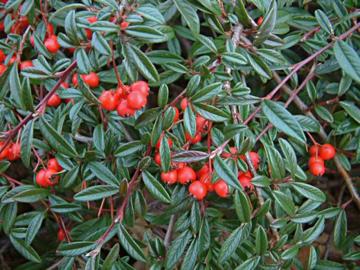Cotoneaster salicifolius
Common name: willow-leaved cotoneaster
Family: Rosaceae
Leaf: alternate, simple, long, lanceolate, dark green, fine grey hairs on undersides, turning maroon in colder months, evergreen to semi-evergreen
Flowers: Compound corymbs of white, 5-petaled, 5-6 mm flowers
Fruit: showy, red, small pomes, ripening Sept-Oct, often persisting into the winter
Habit: low-lying, arched branching small-medium shrub
Form: arching, mounding
Height: up to 3'; Spread: up to 6'
Culture: Best planted in full sun to light shade (better fruiting in full sun). Prefers fertile soils with very good drainage. Hardy to USDA zones 6-9. Drought tolerant once established. May need additional protection from cold winter winds in areas with colder winter climates. Susceptible to fireblight.
Uses: en mass as a groundcover, slope, erosion control, hedge or screen (depending on the cultivar).
Origin: Western China

Family: Rosaceae
Leaf: alternate, simple, long, lanceolate, dark green, fine grey hairs on undersides, turning maroon in colder months, evergreen to semi-evergreen
Flowers: Compound corymbs of white, 5-petaled, 5-6 mm flowers
Fruit: showy, red, small pomes, ripening Sept-Oct, often persisting into the winter
Habit: low-lying, arched branching small-medium shrub
Form: arching, mounding
Height: up to 3'; Spread: up to 6'
Culture: Best planted in full sun to light shade (better fruiting in full sun). Prefers fertile soils with very good drainage. Hardy to USDA zones 6-9. Drought tolerant once established. May need additional protection from cold winter winds in areas with colder winter climates. Susceptible to fireblight.
Uses: en mass as a groundcover, slope, erosion control, hedge or screen (depending on the cultivar).
Origin: Western China

 |
Cotoneaster salicifolius 'Gnom' |
No comments:
Post a Comment